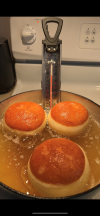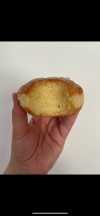I don’t follow anyone online. The vast majority of online “bakers” have no training. They copy all the incorrect information they see on other blogs and perpetuate the misinformation. That’s why they never mention DDT, proofing temperatures and humidity. They never mention protein and ash content of flour. They don’t know not to use flour to knead and just a pinch to roll dough. They don’t distinguish between sugar types because they know what the difference types of sugars are and why you would to do something like add an invert sugar or dextrose to a product. They don’t use baker’s percentages because they don’t understand baking is a chemical reaction.
Pretty much all the information online is incorrect.
If you want be a better home baker, buy AND READ through How Baking Works by Paula Figoni. It’s not a cookbook, but a book on basic ingredients and their role in baking.
Then buy a book like Advanced Bread and Pastry from the San Francisco Baking Institute. It’s a textbook for culinary students, so it’s not formatted like a cookbook. But after you learn the basics on ingredients functions, you will be ready to move on to practice application.
You simply cannot “master” baking while knowing absolutely nothing about the science of baking.
Example, you say you are using 12.5% protein flour. That means you are probably using King Arthur Flour. Which is the wrong flour for any doughnut.
I need to understand how flour is made.
The wheat kernel is divided into its parts: bran (14.5%), wheat germ (2.5%) , endosperm (83%). Each part is miled separately.
The endosperm is milled into two parts: the center is pure starch, and the outer which has some residue of the bran.
These separate millings (streams) are then blended to make various flours. The percentage of each stream in the blend determines the extraction rate. 100% extraction rate means 100% of the kennel is blended make the flour.
In blending flours the percentages of each stream )bran, germ, and endosperm flours) added to the blend are not the same as the original kennel. And different wheats are frequently blended to create flours with certain characteristics.
A flour with all the bran, endosperm and germ, is 100% extraction because it contains 100% of the extraction from the kennel. This is what the retail market calls whole wheat flour.
A flour with 73% extraction is an “all purpose” flour. So more endosperm flour and less bran and germ.
A “cake” flour with 45% extraction has almost no bran and germ.
Flour has treatments, bleached or unbleached. It can also have enzymes in the form of barley flour for better amylase and browning .
Traditional french flours are milled differently. The entire wheat colonel is milled, then desired amount of bran and germ is sifted out for various flour extractions. French flour is labeled T followed by a number:
T45, T55, T65, T70, T80, T110, T150
The T stands for Type and the number is the ash content. Ash is the amount of mineral content in the flour. The ash content comes from the soil and water. It Because bran has a notably higher ash content than endosperm, in other milling ash content is a way for the mill to gauge the consistency and level of bran removed from the endosperm. In French flour ash content is more or less used to determine how much bran and germ is in the flour.
The lower the T number, the less bran and germ in flour. But because the wheat kernel is milled whole, some of the germ and brand becomes embedded in the endosperm flour. The gives the flour a slightly higher protein content and different characteristics than flour mills by separating the wheat kernel. French flours are exceptional for breads.
Unbleached flour with higher protein of 12.7% is not ideal for pastry because of the higher bran and germ content makes a tougher chewier crumb. It also does not rise as well. When you add high sugar and fat to the dough, you further inhibit rise.
You can use an unbleached flour if you don’t want to use bleached. Central Milling Flours sells unbleached flours in various protein/ash contents.
You can also experiment by blending higher and lower protein flours.
I hesitate to get into a lot of discussion about doughnuts because I get bombarded with questions. So I’ve stopped answering doughnut questions. For some reason a lot of people open up donut shops, yet never learn how to make a doughnut.
Shop online for Central Milling Organic flour & grains, Red Rose Conventional Flour and Tony Gemignani Pizza Flour.

centralmilling.com



